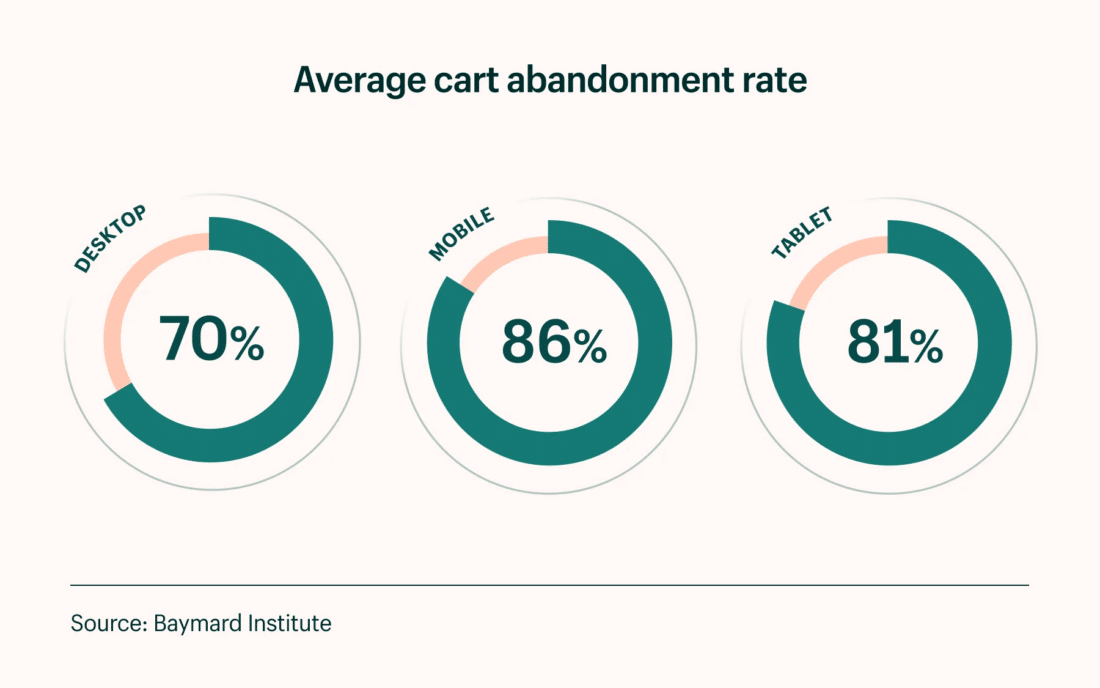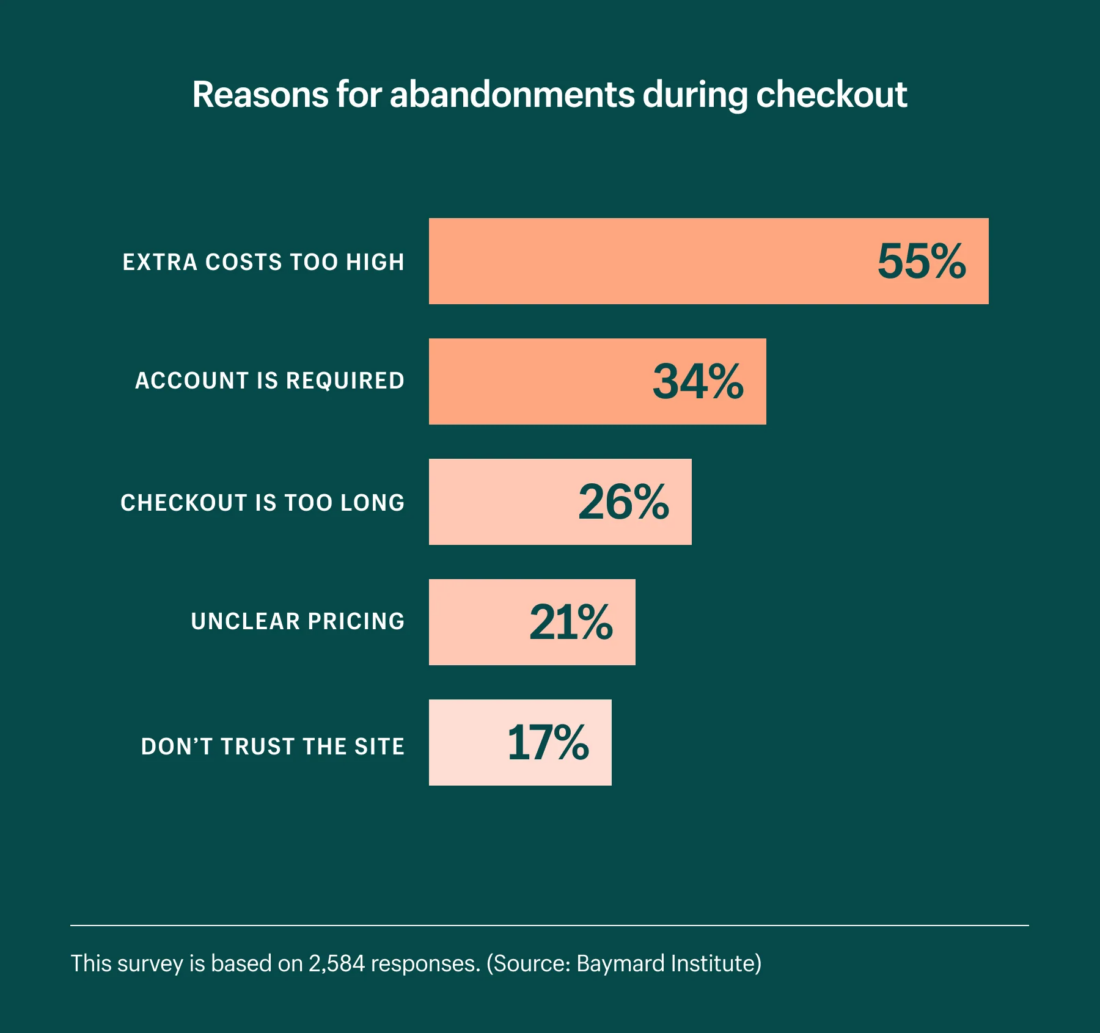The e-commerce checkout experience can be a deal breaker for many consumers, with various issues resulting in shopping cart abandonment. And, not surprisingly, cart abandonment is at its highest in December. However, there are steps you can take to turn curious shoppers into loyal customers.
The more the customer feels valued, the more comfortable they are making a purchase. In this article, we’ll review three potential problems to overcoming the most common checkout challenges, and discuss how to avoid them. Grab a cart and let’s get started!
Why the Checkout Experience Matters to Online Shoppers
At one time or another, most of us have loaded up a digital shopping cart only to abandon it at the last minute. We might have been faced with an overwhelming number of options, or with a confusing or even broken checkout process.
According to recent statistics from Baymard Institute, an estimated 70% of online shopping carts are abandoned before the customer completes a sale. For mobile devices, that number jumps to 85%. Obviously, abandoned carts mean a loss in potential revenue.

There are several reasons shoppers can be highly particular about their checkout experiences. While abandoned carts can have a number of causes, research indicates that shipping costs are a primary factor. In fact, 63% of consumers name shipping as a reason for abandoning the purchase process.
Streamlining your checkout process and creating more mobile-friendly experiences can have a positive impact on your bottom line. In order to do that, you need to understand the factors that influence cart abandonment and how to control them.
3 Ways to Reduce Cart Abandonment
While abandonment may be less of a problem during the holiday shopping season, for example, focusing on the best checkout experience possible is still vital to any e-commerce revenue stream. Understanding the causes of shopping cart abandonment can be helpful in developing better checkout tactics. Let’s explore three potential areas for trouble, and how to address them.

1. Make the Account Sign-In Step Easier
Re-entering shipping or payment information and being forced to create a new account are issues often cited for cart abandonment. This means that unexpected fees and extra steps repeatedly deter shoppers from completing their purchases and converting into paying customers.
One way to combat this kind of abandonment is to offer fast and easy ways for shoppers to retrieve and access information from previously created accounts. You can do this is by offering social login options for one-click sign-ins.
This means that users can use their Facebook, Google, or other social accounts to sign in to your store. Often, these accounts already have payment information stored that can be used quickly. Alternatively, offering a ‘purchase as a guest’ option that does not require signing in is a popular choice.
However, if you want to request payment information directly, one way to make the checkout process easy and reliable is to integrate it with a payment system such as Amazon Pay:
Not only does this option have the backing of a trusted e-commerce entity, but over 100 million people use Amazon Prime. Plus, that includes only the paying Prime customers; it doesn’t account for the 210 million unique monthly visitors to the online retailer who might have Amazon accounts.
A lot of shoppers would likely be interested in using their Amazon information to quickly pay for items elsewhere online. Understanding and improving your payment process with high-quality and recognizable payment options is an excellent way to reduce abandonment.
2. Decide When to Ask for Payment Information
It might seem inconsequential, but the order in which you ask for information during the checkout process can have an impact on whether customers complete their purchases.
Research indicates that if you ask for shipping information first, the customer is making a soft commitment to purchasing. When they are asked for payment information last, on the other hand, they are more likely to complete the purchase.
The theory behind this is that if the payment option is the last step, customers have already put some time and effort into the process and are less likely to abandon it. Plus, by submitting personal information first, such as their names and addresses, shoppers have already made a soft commitment to purchasing the items in their carts.
In contrast, being asked immediately for payment information during the checkout process can be off-putting for consumers. With that in mind, it’s worth evaluating the steps in your checkout process, and making sure you’re leaving those crucial payment-related questions for the end.
3. Keep Customers Informed Throughout the Process
Another way to reduce cart abandonment this shopping season is to make sure your customers are well-informed throughout purchasing. For example, providing a way for customers to view their digital shopping carts without leaving the page being viewed is one way to create a better user experience.
The clothing retailer Abercrombie & Fitch does this elegantly by making the shopping bag a dynamic element. When you mouse over the icon in the upper-right corner of the page, you can interact with the items you’ve placed in the bag without leaving the page:
This can help customers with decision making, and avoids surprises when they’re finally ready to complete their purchases.
Consider targeted discounts to encourage shoppers to return, such as a welcome discount for new visitors and free shipping. (Deloitte found that 85% of shoppers expect free shipping anyway.) Reminding customers that there are items left in their shopping carts can also earn you a second look.
Conclusion
Keeping customers happy and engaged in the virtual checkout line can be difficult, but it is also extremely important. Converting leads into paying customers relies heavily on the quality of that experience. Therefore, reducing checkout ‘pain points’ can greatly improve the likelihood that customers will purchase the items in their digital shopping carts.
Photo by Bastian Riccardi





Ingrid on
I will abandon some carts because coupons and vouchers are not visible or accessible on the site itself, and I have to leave the cart to go search for these offers on the internet. Then I find that the ones I have found are not workable or valid. This takes time, which I mostly do not have. I would prefer these to come up so I can choose which ones to use. Website creators can create a coupon for first time purchasers – and have a button saying ‘click here to get your Welcome offer’. It can be a discount off the next purchase, or an extra item being sent out (ebook?), for instance, or credit points/loyalty points or bonus point for recomending a friend to buy. I even know one woman (Ling’s Cars) who sends you noodles for lunch for free. It’s hilarious and fun and she gets to say that if you lease cars from her, you get a free lunch! I like that. I just got something like this from an online butcher and because of it, have recommended my entire family to buy from them. They are very clever – when someone else buys on my recommendation, THEY get a 15% discount – and so do I! Make it easy for people to join in (it’s not just about buying stuff, it’s about joining your community), and a joy to do business with you (issue lots of quirky surprises to keep people interested), and you will never have to re-invent your order book. Another example: a company that makes French Savon de Marseille, includes a scented gift soap in each parcel (with a new scent that you have not ordered, so they are also marketing their other products to you). How great is that? When you read the reviews, everyone mentions it. I am shortly going to be buying soap from them now too. Food for thought?
Tim on
Experience shows that high shopping cart abandonment rates tell us about some of the problems that exist on e-commerce websites, such as an unsatisfactory user experience or a broken sales funnel. Thus, lowering your shopping cart abandonment rate will lead to increased sales and revenue, and many online stores should pay more attention to optimizing conversion rates.
Also, special attention should be paid to optimizing the page load time and try to create a page taking into account the best customer experience